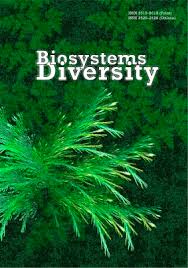Endoparasitoses of the Eurasian collared dove (Streptopelia decaocto) on the northern Black Sea coast of Ukraine
Endoparasitoses of the Eurasian collared dove (Streptopelia decaocto) on the northern Black Sea coast of Ukraine
Author(s): M. Bogach, A. Paliy, P. Liulin, O. Bohach, A. PaliiSubject(s): Energy and Environmental Studies, Regional Geography, Health and medicine and law
Published by: Дніпропетровський національний університет імені Олеся Гончара
Keywords: pigeons; cestodes; nematodes; eimeriosis; trichomonosis; distribution; epidemiology;
Summary/Abstract: One of the main tasks of ecological parasitology at the present stage is to determine patterns of spread of invasive diseases of poultry in the environment through a thorough epidemiological examination, as well as to determine the main directions and factors of spread of parasites in Ukraine. Some pigeon health problems can affect their populations, but parasitic infections play an important role. Our research found that 83.3% of Eurasian collared doves examined (Streptopelia decaocto) were affected by endoparasites. The commonest helminths were Raillietina spp. with the average invasion intensity of 4.9 ± 1.3 specimens/ind., Baruscapillaria spp. and Ascaridia columbae with an invasion intensity of 4.6 ± 1.5 and 3.7 ± 2.1 specimens/ind., respectively. The commonest cestodes were Raillietina spp. with the extent of invasion of 52.2% and Davainea proglottina – 6.7%. The Amoebotaenia cuneata cestodes were recorded in 3 (3.3%) doves, and Echinolepis carioca – only in 2 (2.2%) doves. Six doves (6.7%) were infected with the nematode Ascaridia columbae and 5 (5.6%) – Baruscapillaria spp. Eimerian oocysts were found in 9 (10%) collared doves, and Trichomonas gallinae was recorded in 15 (16.7%) birds. According to the results of helminthological autopsy and identification of the isolated pathogens, 8 varieties of mixinvasions were identified. In association with the Rayetins, there were the protozoa Eimeria spp. and Trichomonas gallinae and the nematode Ascaridia columbae. Two-component invasions were registered in 78.6% of doves, three-component infestations in 14.3% and four-component infestations in 7.1% of birds. Mixed infection with Raillietina spp. + Ascaridia columbae was found in the small intestine of Streptopelia decaocto, which was also pathomorphologically observed to have catarrhal-hemorrhagic enteritis, which was accompanied by the formation of a large number of spotted hemorrhages on the mucous membrane, and in the places of attachment of cestodes - necrotic-caseous areas. Temperature and other weather conditions such as humidity, precipitation, etc. of the northern Black Sea coast affect the population size of intermediate host cestodes. Continuous monitoring of invasive diseases of pigeons of different species will help to take the necessary preventive measures against endoparasitoses of birds.
Journal: Biosystems Diversity
- Issue Year: 29/2021
- Issue No: 4
- Page Range: 340-344
- Page Count: 5
- Language: English

